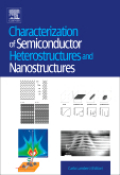
Characterization of semiconductor heterostructures and nanostructures
Lamberti, Carlo
"Characterization of Semiconductor Heterostructures and Nanostructures" is structured in chapters, each one devoted to a specific characterization technique used in the understanding of the properties (structural, physical, chemical,electrical etc.) of semiconductor quantum wells and superlattices. A chapter is devoted to the ab initio modeling. The book has basically a double aim. Thefirst one lies on the educational ground. The book provides the basic conceptof each of the selected techniques with an approach understandable by master and PhD students in Physics, Chemistry, Material Science, Engineering, Nanotechnology.The second aim is to provide a selected set of examples from the recent literature of the TOP results obtained with the specific technique in understanding the properties of semiconductor heterostructures and nanostructures. Each chapter has this double structure: a first part devoted to explain the basic concepts, providing the larger possible audience, and a second one to the discussion of the most peculiar and innovative examples, allowing the book to have the longer possible life time. Of course, the book is devoted to the specialized subset of scientists working in the fields of design, growth, characterization, testing of heterostructures-based devices in both academic and industrial laboratories.But the final goal is somewhat more ambitious, and in this regard the topic of quantum wells, wires and dots should be seen as a pretext of applying top level characterization techniques in understanding the structural, electronic etc...properties of matter at the nanometer (even sub-nanometer) scale. In this way it is aimed to become a reference book in the much broader, and extremely hot, field of Nanotechnology. INDICE: Chapter 1. Introduction (C. Lamberti) Chapter 2. Ab-initio studiesof structural and electronic properties (M. Peressi, A. Baldereschi and S. Baroni) Chapter 3. Electrical and optical properties of heterostructures (TBC) Chapter 4. Strain and composition determination in semiconducting heterostructures by high resolution X-ray diffraction (C. Ferrari and C. Bocchi) Chapter 5.Transmission Electron Microscopy techniques for imaging and composition evaluation in Semiconductor Heterostructures (L. Lazzarini, L. Nasi and V. Grillo) Chapter 6. Accessing structural and electronic properties of semiconductor nanostructures via photoluminescence (S. Sanguinetti, M. Guzzi and M. Gurioli) Chapter 7. Power dependent cathodoluminescence in III-Nitrides heterostructures:from internal field screening to controlled band gap modulation (G. Salviati,L. Lazzarini, N. Armani, F. Rossi and V. Grillo) Chapter 8. Raman Spectroscopy (D. Wolverson) Chapter 9. X-ray absorption fine structure spectroscopy (F. Boscherini) Chapter 10. Nanostructures in the light of synchrotron radiation: surface sensitive x-ray techniques and anomalous scattering (T. Metzger, J. Eymery, V. Favre-Nicolin, G. Renaud, H. Renevier and T. Schulli) Chapter 11. Grazing Incidence Diffraction Anomalous Fine Structure to study the structural properties of semiconductor nanostructures (M. Grazia Proietti, J. Coraux and H. Renevier) Chapter 12. The Role of Photoemission Spectroscopies in Heterojunction Research (G. Margaritondo) Chapter 13. EPR of interfaces and nanolayers in semiconductor heterostructures (A. Stesmans and V.V. Afans'ev)
- ISBN: 978-0-444-53099-8
- Editorial: Elsevier Science
- Encuadernacion: Cartoné
- Páginas: 538
- Fecha Publicación: 01/06/2008
- Nº Volúmenes: 1
- Idioma: Inglés
